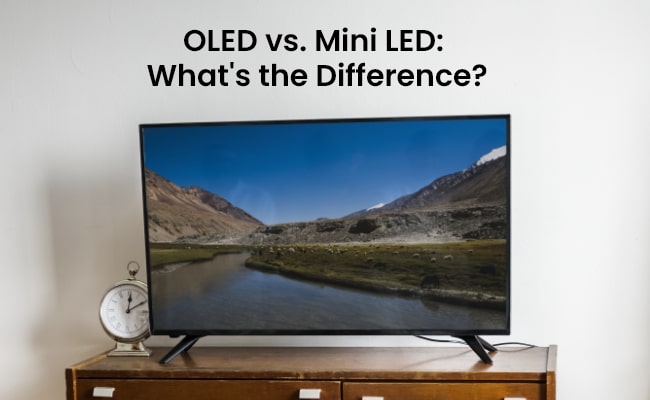Mini LED vs OLED: Which One Offers Better Picture Quality?

The more technology advances, the more options consumers have when picking their next display. Today, one of the most common dilemmas is between Mini LED or OLED, two display technologies that have changed the way we consume visual content. So, which one really gives you better picture quality? In this article, we’ll look at Mini LED vs OLED in more detail, what each has to offer, and what each has to offer in terms of color accuracy, contrast, cost, and downsides.
Mini LED vs. OLED: Understanding the Basics
First, let’s understand what OLED or Mini LED displays are and what makes them special before we get into the nitty-gritty.
What is Mini LED?
Mini LED, or Mini Light Emitting Diode, is a display technology that uses thousands of small LEDs as the backlight for an LCD panel. Unlike traditional LED displays, these LEDs are smaller, which means more precise dimming zones and better control over brightness and contrast. Mini LED technology attempts to improve picture quality by boosting brightness and contrast without going to the cost and potential downsides of OLED.
What is OLED?
OLED stands for Organic Light Emitting Diode, a display technology where each pixel generates its own light, so it doesn't need a backlight. OLED screens have an emissive quality, which means they can achieve perfect blacks, high contrast ratios, and great color accuracy. OLED displays are famous for their excellent image quality, especially in dark environments, and their vibrant colors. But they also carry their own pitfalls, including the possibility of burnout.
Don’t miss Reolink’s Holiday Sales for exclusive discounts on security cameras!
Reolink New Year Sale - Save Big with Exclusive Deals!
Save big with Reolink! New Year Sale up to 45% off on security cameras, doorbells, and systems — Dec. 8 to Jan. 4.
OLED vs. Mini LED: What’s the Difference?
Mini-LED vs OLED both promise to provide stunning visuals, but they go about it very differently. So, let’s talk about some of the critical differences between MiniLED vs OLED.
Sharpness and Resolution
Sharpness and resolution are among the first areas in which OLED and Mini LED differ. The ability to produce each pixel's light typically gives OLED panels excellent sharpness so they can show finer image details. Mini LED is not self-emissive but can also offer high resolution, especially for 4K and 8K displays. However, OLED has the edge in reproducing fine details.
Brightness and Contrast
Two of the biggest differences between Mini LED and OLED are brightness and contrast. Perfect blacks can be achieved by turning off individual pixels in OLEDs, resulting in virtually infinite contrast. Mini LED is brighter, but it uses a backlight, so it can’t turn off pixels completely, and there may be some ‘blooming’ around bright objects on dark backgrounds. However, Mini LEDs are usually brighter, so they are a better option for well-lit rooms.
Viewing Angles
OLED displays are very good at viewing angles. With self-emissive pixels, they offer consistent color and brightness no matter where you’re sitting. OLED is better if you tend to watch TV with others from different seating positions, as mini LED panels can suffer from color and contrast degradation at wider angles.
Color
Another area where OLED and Mini LED differ is color reproduction. OLED panels tend to have more vibrant, more accurate colors because they have pixel-level lighting control. While mini LED displays offer improved color accuracy compared to traditional LED, they also rely on a backlight, which can hinder their ability to reach the same level of vibrancy and precision in colors.
Burn-in
One drawback of OLED displays is burn-in, which is when static images left on the screen for long periods leave a permanent mark. Unlike mini LED, however, it does not suffer from burn-in, which makes it a better choice for situations where static images are commonly shown, such as in gaming HUDs or news tickers.
Black Levels
A perfect black level is one of the most celebrated aspects of OLED technology. OLED pixels can turn off completely, which creates true blacks and adds depth and realism. Standard LED black levels are improved by mini LED, but since it uses a backlight, it can’t reach the same deep blacks as OLED.
Response Time
Gaming and fast action scenes in movies require response time. OLED typically has the fastest response times because it is self-emissive, reducing motion blur. While mini LED has improved over traditional LED, it still falls just a bit short of OLED.
Size and Cost
OLED displays are more expensive to produce than Mini LED displays, especially in larger sizes. The goal of Mini LED is to deliver high-quality visuals at a more affordable price, particularly in larger formats. Mini LED might be the more economical option if budget and screen size are concerns.
Mini LED TV vs. OLED: Pros & Cons
Both show types have their advantages and their disadvantages. Let’s take a look at some of the pros and cons of Sony Mini LED vs OLEDs.
Mini LED TV: Pros and Cons
Pros:
- Ideal for bright rooms, high-brightness
- Better contrast than traditional LED.
- Affordable in larger sizes
- No risk of burn-in
Cons:
- Limited viewing angles
- Not capable of true blacks
- Bloom effect around bright objects may be possible
OLED TV: Pros and Cons
Pros:
- Perfect blacks and infinite contrast.
- Excellent color accuracy
- Superior viewing angles
- Fast response times
Cons:
- Higher cost, especially in larger sizes.
- Burn in with static images.
- Less bright than the Mini LED
Is Mini LED Better than OLED? How to Choose?
So, is Mini LED better than OLED? It depends on how and where you are going to use your display. A Mini LED may be the best option if you want a TV for a brightly lit room because Mini LEDs are brighter than other LEDs. They are also less expensive, so they make for a good choice for larger screens on a budget.
OLED is often preferred for dark rooms and immersive viewing experiences, as it exhibits perfect blacks, wider viewing angles, and better contrast. OLED may be the better option for gamers and movie enthusiasts who want the best in visual fidelity and are concerned about motion blur.
If you have to choose between Mini LED and OLED, take into account room lighting, budget, viewing angles, and how you’re going to use the display.
OLED vs. QLED vs. Mini LED: Comparison Table
Here’s a quick comparison of OLED, QLED, and Mini LEDs to help you understand the significant differences.
FAQs
Is a Mini-LED display better than an OLED?
It depends on your usage. Mini LED is better for bright rooms and is more affordable for larger screens. However, OLED offers better contrast, black levels, and color accuracy, which makes it perfect for a cinematic experience in darker environments.
Is Apple Mini-LED better than OLED?
Apple’s Mini LED displays are brighter and have better contrast than standard LED, but black levels and viewing angles are still better on OLED. Which one you choose depends on your preference and how you will use the display.
What are the disadvantages of a Mini-LED TV?
Mini LED TVs are excellent for brightness and contrast but have poor viewing angles, can’t get true blacks like OLED, and may display a “blooming” effect around bright objects on dark backgrounds.
Conclusion
The Mini LED vs. OLED battle pits two technologies with different strengths and weaknesses against each other. Solid picture quality and a bright, cost-effective solution make Mini LED a great choice for bright environments and larger screen sizes. OLED, meanwhile, offers unmatched black levels, color accuracy, and response times and is the superior option for darker rooms and more immersive viewing. You will choose based on your budget, your viewing conditions, and your preferences.
What’s your take? Which technology would you use for your next display and why? Let me know if you have any thoughts in the comments!
Search
Subscribe for the Latest Updates
Security insights & offers right into your inbox

